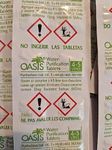Buying Guide for the Best Water Purification Tablets
When choosing water purification tablets, it's important to consider several key factors to ensure you select the right product for your needs. Water purification tablets are essential for making water safe to drink, especially in situations where clean water is not readily available, such as during camping trips, hiking, or emergency situations. Understanding the key specifications will help you make an informed decision and ensure you have safe drinking water when you need it.Active IngredientThe active ingredient in water purification tablets is the chemical compound responsible for killing harmful microorganisms in the water. Common active ingredients include chlorine, iodine, and chlorine dioxide. Chlorine and iodine are effective against bacteria and viruses but may not be as effective against certain protozoa. Chlorine dioxide is effective against a broader range of pathogens, including protozoa. Choose the active ingredient based on the types of contaminants you are most likely to encounter and any personal sensitivities or allergies.
Purification TimePurification time refers to the amount of time it takes for the tablets to effectively disinfect the water. This can range from 30 minutes to 4 hours, depending on the active ingredient and the level of contamination. If you need water quickly, look for tablets with a shorter purification time. However, if you have the luxury of waiting, tablets with a longer purification time may offer more thorough disinfection.
Water Volume TreatedThis specification indicates the amount of water that can be treated with a single tablet. Some tablets are designed to treat 1 liter of water, while others can treat up to 5 liters. Consider how much water you will need to purify at one time. For individual use, tablets that treat 1 liter may be sufficient, but for group use or longer trips, you may want tablets that can treat larger volumes of water.
Shelf LifeShelf life refers to the length of time the tablets remain effective when stored properly. This can range from 2 to 5 years. If you are purchasing tablets for emergency preparedness, a longer shelf life is beneficial. For regular use, such as camping or hiking, a shorter shelf life may be acceptable as you will likely use the tablets more frequently.
Taste and OdorSome water purification tablets can leave an unpleasant taste or odor in the treated water, which can be off-putting for some users. Chlorine and iodine tablets are more likely to affect the taste and smell of the water, while chlorine dioxide tablets tend to have less impact. If taste and odor are important to you, look for tablets that are specifically designed to minimize these effects or consider using a neutralizing tablet to improve the taste.
Ease of UseEase of use refers to how simple and straightforward the tablets are to use. Some tablets require multiple steps or additional equipment, while others are as simple as dropping a tablet into the water and waiting. If you prefer a hassle-free experience, look for tablets that are easy to use and come with clear instructions. This is especially important in emergency situations where time and resources may be limited.
















